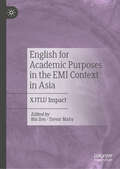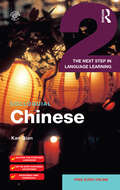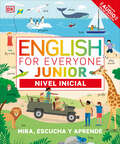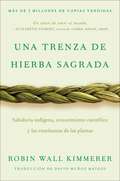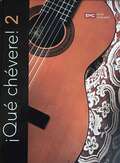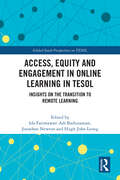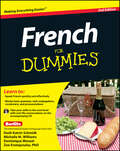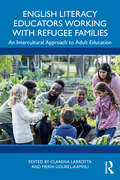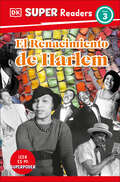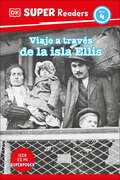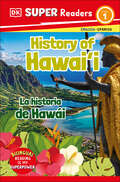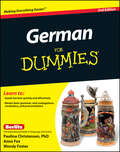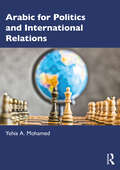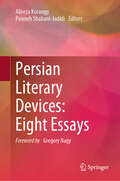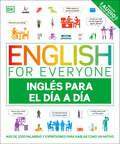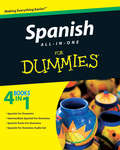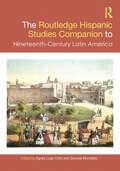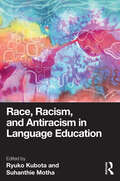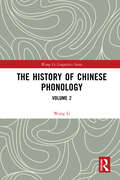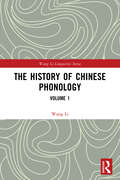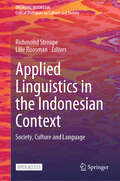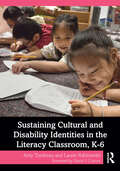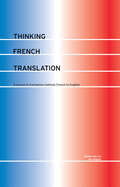- Table View
- List View
English for Academic Purposes in the EMI Context in Asia: XJTLU Impact
by Bin Zou Trevor MahyThis edited book focuses on English for Academic Purposes (EAP) within the English as a Medium of Instruction (EMI) context in Asia, with a specific emphasis on the impact of EAP at Xi'an Jiaotong-Liverpool University (XJTLU) in China. Celebrating over 15 years of EAP provision at the university, the authors showcase research and best practices in EAP across various academic disciplines and address the growing need for tailored EAP teaching resources in the EMI environment. The volume presents evidence of XJTLU’s dedication to pedagogical innovations and to the professional development of its teaching staff, and includes studies of EAP pedagogies at undergraduate, taught Master’s, and doctoral levels, with diverse instructional and innovative foci. This book will be of interest to teachers, researchers, postgraduate students, and university policy makers, as well as anyone with a background in English for Academic Purposes (EAP) or English as a foreign language (EFL) teaching.
Colloquial Chinese 2: The Next Step in Language Learning (Colloquial Series)
by Kan QianColloquial Chinese 2 is designed for those who already have some knowledge of Chinese. It is ideal for refreshing and extending your grasp of Chinese grammar and vocabulary, either in preparation for travel or work. Key features include revision material to help the consolidation of basics a range of Chinese reading texts presented in simplified characters and pinyin romanization lessons based on practical everyday topics and supplemented by useful cultural notes lots of spoken and written exercises in each lesson for practice and consolidation a grammar summary detailed answer key Chinese-English glossary Audio material to accompany the course is available to download free in MP3 format from www.routledge.com/cw/colloquials. Recorded by native speakers, the audio material features the dialogues and texts from the book and will help develop your listening and pronunciation skills.
English for Everyone Junior Nivel inicial (DK English for Everyone Junior)
by DK¡Mira, escucha y aprende inglés con este divertido libro para principiantes! Con English for Everyone Junior: Nivel inicial, ¡no necesitas tener conocimientos previos de inglés para empezar a dominar el idioma! Este libro para niños de 6 a 10 años se convertirá en el compañero ideal de tus hijos para aprender inglés, con gramática y vocabulario de temas esenciales como la familia, el colegio, los animales, la casa, el cuerpo humano, la comida, la ropa ¡y mucho más! Repleto de ejercicios sencillos y audios que te permitirán hablar y leer más de 500 palabras en tiempo récord.Perfecto tanto para estudiar en casa como en el colegio.Con explicaciones de reglas gramaticales inglesas acompañadas de ejemplos claros de cuándo se usan.Incluye una guía de escritura a mano y un glosario de los términos lingüísticos utilizados a lo largo del libro.Un recurso ideal que te proporcionará todo el apoyo que necesitas para aprender inglés desde cero, ya que te guía por los conceptos básicos del idioma y te ayuda a usar y comprender el inglés básico con claridad y confianza.La colección English for Everyone de DK es una forma fácil y divertida de aprender inglés. Con audios de apoyo e innovadores ejercicios que cubren todos los aspectos clave del idioma, estos libros ilustrados reemplazan las complicadas y aburridas explicaciones con imágenes divertidas y gráficos claros, para aprender visualmente y que la gramática y el vocabulario resulten fáciles de recordar. ¡Aprender inglés no ha sido nunca tan fácil!Learn English with this fun course for complete beginners. Simple exercises and lively audio will have you speaking and reading more than 500 words in no time!The perfect introduction to English vocabulary and grammar, English for Everyone Junior: Beginner's Course provides children aged 6-9 with the support they need as they take the first steps towards learning English as a foreign language.Equally effective for home study or the classroom, this carefully leveled English-language course assumes no previous knowledge of English. It takes children through the basics of the language, helping them use and understand elementary English clearly and confidently.Vocabulary is taught through attractive illustrations and reinforced with audio resources. Each language/grammar point is explained in a dedicated panel, accompanied by clear examples of how it's used, and reinforced by exercises. At the back, there is a handwriting guide, grammar overview, and a glossary of language terms used throughout the book.Building on the worldwide success of the English for Everyone series, the Junior Beginner's Course contains everything a child needs to acquire a firm grasp of English in a fun and interactive way.
Braiding Sweetgrass / Una trenza de hierba sagrada (Spanish edition): Sabiduría indígena, conocimiento científico y las enseñanzas de las plantas
by Robin Wall KimmererUno de los libros más importantes de nuestros tiempos, que nos invita a descubrir un nuevo lenguaje para comunicarnos con la naturaleza y recibir sus enseñanzas. Como mujer indígena, Robin Wall Kimmerer es heredera de un valioso legado que considera a los animales y las plantas nuestros mejores maestros. Como botánica, se ha valido del rigor científico para estudiar mejor la naturaleza. Y como madre, profesora y escritora, ha dedicado su vida a conjugar ambas perspectivas para abogar por un despertar de la consciencia ecológica que reconozca y celebre nuestra profunda conexión con otras formas de vida.En Una trenza de hierba sagrada, la autora entreteje experiencias y saberes en una serie de relatos iluminadores y emotivos que nos inspiran a fortalecer nuestra relación sagrada con la Madre Tierra. Cada capítulo es una magnífica lección de gratitud y reciprocidad, que nos recuerda que, si ofrecemos nuestros dones al mundo y lo ayudamos a sanar, este nos retribuirá con la armonía y el bienestar que tanto anhelamos.Bestseller del New York TimesBestseller del Washington PostBestseller del Los Angeles Times«Mejor Colección de Ensayos de la Década» según Literary Hub———A masterpiece of our times, inviting us to discover a new language for communicating with nature and receiving its lessons.As a Native American woman, Robin Wall Kimmerer is the heir to a valuable legacy that views animals and plants as our greatest and oldest teachers. As a botanist, she leverages scientific knowledge to better understand nature. And as a mother, teacher, and writer, she has dedicated her life to blending these perspectives and advocate for an awakening of ecological consciousness that acknowledges and celebrates our deep connection with other forms of life.In Braiding Sweetgrass, the author weaves together experiences and knowledge in a series of illuminating and emotional stories that inspire us to reinvigorate our sacred relationship with Mother Earth. Each chapter offers a magnificent lesson in gratitude and reciprocity, reminding us that if we contribute our gifts to the world and help it heal, it will reward us with the harmony and wellness we are yearning for.A New York Times BestsellerA Washington Post BestsellerA Los Angeles Times BestsellerNamed a “Best Essay Collection of the Decade” by Literary Hub
Colloquial Chinese 2: The Next Step in Language Learning (Colloquial Series)
by Kan QianColloquial Chinese 2 is designed for those who already have some knowledge of Chinese. It is ideal for refreshing and extending your grasp of Chinese grammar and vocabulary, either in preparation for travel or work. Key features include revision material to help the consolidation of basics a range of Chinese reading texts presented in simplified characters and pinyin romanization lessons based on practical everyday topics and supplemented by useful cultural notes lots of spoken and written exercises in each lesson for practice and consolidation a grammar summary detailed answer key Chinese-English glossary Audio material to accompany the course is available to download free in MP3 format from www.routledge.com/cw/colloquials. Recorded by native speakers, the audio material features the dialogues and texts from the book and will help develop your listening and pronunciation skills.
Access, Equity and Engagement in Online Learning in TESOL: Insights on the Transition to Remote Learning (Global South Perspectives on TESOL)
by Jonathan Newton Adi Badiozaman, Ida Fatimawati Hugh John LeongThis volume explores difficulties facing TESOL education’s transition to online learning in the Global South and Southeast Asia/Asia Pacific region, highlighting innovations of educators in engaging learners, thereby exploring the key themes of access, engagement, and equity in the field.Discussing themes such as academic burnout, cultural competence, and emotional regulation strategies in challenging educational contexts, this novel volume gives voice to field experiences encountered in countries such as Malaysia, Indonesia, Oman, Vietnam, China, and Iran. Chapters demonstrate how a lack of access to reliable internet connectivity and a shortage of digital devices, especially in rural areas, compound limited opportunities for students already facing educational inequalities, presenting the innovative and creative ways English educators are responding to these situations. Across interviews and qualitative studies, the book demonstrates that issues surrounding engagement with, access to, and equity within, the remote and online educational context are wider and longer lasting than the recent pandemic period itself and are at the forefront of challenges facing these regions today.Highlighting English educators’ resilience, perseverance, and creativity in challenging circumstances, the book will be of interest to researchers, scholars, and postgraduate students in open and distance education, eLearning, bilingualism/ESL, and distribution of technology in educational settings.
French For Dummies
by Michelle M. Williams Dodi-Katrin Schmidt Dominique Wenzel Zoe ErotopoulosThe fast, informal way to learn to speak French - with integrated audio clips throughout. Listen to pronunciations and conversations. French is a beautiful language but quite difficult to learn. Whether you need to learn the language for a French class, or you travel overseas for business or leisure, this enhanced edition of French for Dummies can help. Written in an easy-to-follow format, with integrated audio clips, it gives you just what you need for basic communication in French. The enhanced edition includes: Expanded coverage of necessary grammar, vocabulary, and pronunciations Useful exercises, practice questions, and a mini-dictionary Business, an upcoming class, travel – whatever your reason for wanting to learn a new language but don't have time to take a class, this enhanced edition of French For Dummies can get you well on your way to becoming fluent in no time!
English Literacy Educators Working with Refugee Families: An Intercultural Approach to Adult Education
by Clarena Larrotta Merih Ugurel-KamisliEnglish Literacy Educators Working with Refugee Families highlights best practices for English literacy instruction when working with refugees in the United States. Given the global refugee crisis around the world, the topic of teaching language to refugees is of increasing importance. The volume addresses this pressing issue and provides valuable insights and tools for educators working with refugees and immigrants in a variety of programs.With contributions from authors who have experience teaching refugees, the book details innovative strategies and first-hand knowledge grounded in theory, research, and practice in adult education. Book contributors provide a review of the contexts for teaching refugees and illustrate the importance of implementing an intercultural communicative framework in the English literacy classroom.The book will be beneficial to pre-service teachers, students in undergraduate and graduate programs learning about adult literacy education, as well as educators and researchers interested in refugee education.
DK Super Readers Level 3 El Renacimiento de Harlem (DK Super Readers)
by DKAyude a su niño a fortalecer sus destrezas de lectura y aprender acerca de las vidas, música, arte e ideas emocionantes que florecieron en la comunidad afroamericana de Harlem hace cien años con este texto informativo repleto de datos verídicos y graduado cuidadosamente para apoyar el progreso de los pequeños lectores.¿Cómo era el Harlem afroamericano de la década de 1920, con su explosión de nuevas ideas, música, arte y estilo?Un texto cautivador graduado cuidadosamente con el sistema Lexile para proveerles a los niños lo que necesitan para encarar con éxito la lectura.Una introducción motivadora al uso de las destrezas básicas para la lectura de textos informativos.A los niños les encantará aprender sobre la creatividad y los logros de la comunidad afroamericana durante el increíble lugar y momento conocido como "el Renacimiento de Harlem".- - - - - - - - - - - - - -Help your child power up their reading skills and learn about the exciting lives, music, art and ideas of the African American community of Harlem 100 years ago in this fact-filled-nonfiction reader—carefully leveled to help children progress.What was it like in the African American Harlem of the 1920s, bursting with new ideas, music, art, and style?The engaging text has been carefully leveled using Lexile so that children are set up to succeed.A motivating introduction to using essential nonfiction reading skills.Children will love to find out about the creativity and achievements of the African American community during the incredible place and time known as the ‘Harlem renaissance’.
DK Super Readers Level 4 Viaje a través de la isla de Ellis (DK Super Readers)
by DKIdea básicaAprende acerca de la experiencia de los inmigrantes que llegaron a la isla Ellis hace más de cien años. ¡Convierte la lectura en uno de tus superpoderes con nuestros DK Super Readers informativos!- - - - - - - -Help your child power up their reading skills and learn all about Ellis Island and the people arriving there at the turn of the 20th century with this fact-filled nonfiction reader – carefully leveled to help children progress.Explore the history of the world-famous Ellis Island, and the stories of people traveling through one of the most recognized places in the USA.The engaging text has been carefully leveled using Lexile so that children are set up to succeed.A motivating introduction to using essential nonfiction reading skills.Children will love to find out about the history of one of the USA’s most famous landmarks.
DK Super Readers Level 1 Bilingual History of Hawai'i – La historia de Hawái (DK Super Readers)
by DKHelp your child power up their reading skills and learn all about this American island state in the Pacific Ocean with this fun-filled nonfiction reader–carefully leveled to help children progress.DK Super Readers Level 1: History of Hawaii will introduce kids to the history of this unique American state—and is a motivating introduction to using essential nonfiction reading skills, proving ideal for children ready to enter the riveting world of reading. DK Super Readers take children on a journey through the wonderful world of nonfiction: traveling back to the time of dinosaurs, learning more about animals, exploring natural wonders and more, all while developing vital nonfiction reading skills and progressing from first words to reading confidently. The DK Super Readers series can help your child practice reading by:- Covering engaging, motivating, curriculum-aligned topics.Building knowledge while progressing core Grade 1 and 2 reading skills.- Developing subject vocabulary on topics such as inventions, inventors, and history.- Boosting understanding and retention through comprehension quizzes.Each title, which has been leveled using MetaMetrics®: The Lexile Framework for Reading, integrates science, geography, history, and nature topics so there’s something for all children’s interests. The books and online content perfectly supplement core literacy programs and are mapped to the Common Core Standards. Children will love powering up their nonfiction reading skills and becoming reading heroes. DK Super Readers Pre-level titles are visually engaging and expand subject knowledge and vocabulary for young readers who want to learn more about the world around them. Perfect for children ages 6 to 8 (Grades 1 and 2) who are learning to read with help.
German For Dummies
by Paulina Christensen Anne Fox Wendy FosterThe fun and easy way to learn the fascinating language of German with integrated audio clips! German For Dummies, Enhanced Edition uses the renowned Berlitz approach to get you up and running with the language-and having fun too! Designed for the total beginner, this guide introduces you to basic grammar and then speedily has you making conversation. Integrated audio clips let you listen and learn as you hear pronunciations and real-life conversations. Fun and games sections ease your way into German fluency, phonetic spellings following expressions and vocabulary improve your pronunciation, and helpful boxes and sidebars cover cultural quirks and factoids. Master the nuts and bolts of German grammar Learn phrases that make you sound German-and know what never to say in German Whether you're just looking for a greeting besides "Guten tag" or you want to become a foreign exchange student, this enhanced edition of German For Dummies gives you what you need to learn the language-as much as you like, as fast as you like!
Arabic for Politics and International Relations
by Yehia A. MohamedArabic for Politics and International Relations is the first textbook for high-intermediate to advanced students of Arabic that focuses on Arabic as it is used in the fields of politics, diplomacy, governance, and international relations.Thematically organised, each chapter includes a selection of authentic reading texts that demonstrate the language in use while introducing students to a key topic or theme such as political systems, government, human rights, conflict resolution, and defence. Each chapter has a range of exercises that include comprehension questions, questions designed to develop vocabulary, understanding the morphology, rhetoric and style. There are a range of activities that allow students to practice all four language skills: reading, listening, speaking, and writing.Arabic for Politics and International Relations is ideal for advanced- level Arabic courses.
Persian Literary Devices: Eight Essays
by Azadeh VatanpourThis volume offers a glimpse into the rich tradition of literary devices in Persian language and literature. It establishes an incontrovertible connection between literary devices - figurative language, rhetoric, and so on - and pedagogy and poetics in both written and oral expression. The essays offer a detailed and thorough overview of some of these literary devices and their dynamics, which have helped make the Persian literary tradition a force to reckon with. The essays also carve out a space dedicated to colloquialisms and idioms, as they are interwoven into the fabric of Persian culture— within the larger field of rhetoric. These devices are fostered and furthered in their potency, both culturally and linguistically, by the poets, writers, and rhetoricians who utilize them. The essays highlight a culture and history in texts and oral history that further speak to a culturally tailored complexity as per figurative language, idioms, colloquialisms, and therhetoric they help found and/or re-define. These discussions and analyses further facilitate an understanding of the epistemological and cultural meaning of some of the constituents of what is otherwise a Persian identity. This work is a must-have for scholars and students of Persian, Arabic, Ottoman, and Urdu literature, not to mention Middle Eastern history and cultural poetics enthusiasts.
English for Everyone Inglés para el día a día (DK English for Everyone)
by DK¡Lleva tus habilidades de comunicación en inglés a otro nivel! Si necesitas aprender inglés para trabajar, estudiar, viajar o incluso mudarte, este libro será tu mayor aliado.English for Everyone: Everyday English te ayuda a expresarte en inglés en tu día a día con confianza. Aprende a comunicarte en diferentes escenarios del mundo real, desde actividades como ir al supermercado, pedir comida a domicilio o concertar citas, hasta conversaciones clave como consolar a alguien o lidiar con un conflicto.En las páginas de este libro de inglés para jóvenes y adultos, encontrarás: Más de 1500 frases y expresiones útiles para practicar tu inglés.Cada unidad incluye diálogos realistas y fáciles de memorizar.Ejercicios prácticos para reforzar el vocabulario y las frases que has aprendido en cada tema.Atractivas imágenes que acompañan los diferentes diálogos.Vídeos y audios de hablantes de inglés nativos, disponibles en nuestra página web y aplicación gratuitas.Una excelente herramienta de apoyo tanto para estudiantes que están preparando sus exámenes oficiales TOEFL, IELTS y TOEIC, como para viajeros o profesores. Mejora tu inglés oral de forma amena y divertida y enfréntate a situaciones cotidianas, como charlas en la oficina o reservas de viajes, más fácilmente. La colección English for Everyone de DK es una forma fácil y divertida de aprender inglés. Con audios de apoyo e innovadores ejercicios que cubren todos los aspectos clave del idioma, estos libros ilustrados sustituyen complicadas explicaciones por imágenes y gráficos claros, para aprender visualmente y que la gramática y el vocabulario resulten fáciles de recordar. ¡Aprender inglés no ha sido nunca tan fácil!Speak English with confidence in a wide range of everyday situations, from making small talk to booking a trip abroad. With more than 1,500 of the most useful phrases and common expressions, English for Everyone: Everyday English gives you all the English conversation skills you need to get by in the real world.This engaging and accessible book covers a wide range of real-life topics and scenarios – from everyday activities, such as going to the supermarket and making appointments, to key communication skills, such as comforting someone and dealing with conflict. You’ll learn how to welcome visitors, ask for directions, give a presentation at work, find somewhere to live, order a meal out, and much, much more.Each short unit uses memorable, true-to-life dialogues to introduce a new topic, followed by practice exercises to reinforce the new words and phrases that you have learned. The dialogues are accompanied by attractive illustrations and brought to life by animated videos and audio featuring speakers of English as a first language, all available on the free English for Everyone website and app. Whether you need to learn English for work, study, travel, or relocation, English for Everyone: Everyday English is the perfect companion to help you take your English skills to the next level.
Spanish All-in-One For Dummies
by The Experts at For DummiesA value-packed guide to speaking, reading, and writing in Spanish Spanish All-in-One For Dummies is the first Dummies All-in-One title in the foreign language category–nearly 800 pages of expert instruction to help people master Spanish basics and beyond. This comprehensive volume features content from all For Dummies Spanish language instruction titles, including Spanish For Dummies, Intermediate Spanish For Dummies, Spanish Verbs For Dummies, and Spanish For Dummies Audio Set. The book's audio CD provides readers with an effective tool to help them start speaking Spanish from day one. Plus, the practical exercises give readers greater confidence in communicating in Spanish, whether traveling or in business.
Multimodal Funds of Knowledge in Literacy: Countering Deficit Narratives of Diverse Families
by Sally Brown Rong ZhangApplying an asset-based approach, Multimodal Funds of Knowledge in Literacy prepares educators to teach and support diverse students and their families as they negotiate multimodal aspects of literacy learning. Framed by sociocultural theory, multiliteracies, multimodality, and posthumanism, the text combats deficit narratives by providing concrete alternatives that push educators to rethink their practices and support students’ and families’ cultural and linguistic strengths.Chapters include case studies, vignettes, prompts, and learning samples that will leave readers with valuable insights and new understandings of multimodal funds of knowledge. Comprehensive and instructive, this book is a key text in literacy education, family literacy, and community engagement.
The Routledge Hispanic Studies Companion to Nineteenth-Century Latin America (Routledge Companions to Hispanic and Latin American Studies)
by Agnes Lugo-Ortiz Javier Muñoz-Basols Pablo Valdivia Graciela MontaldoThe Routledge Hispanic Studies Companion to Nineteenth-Century Latin America provides a unique, comprehensive, and critical overview of Latin American studies in the nineteenth century, including the major regions and subfields.The essays in this collection offer a complex, yet accessible transdisciplinary overview of the heterogeneous and asynchronous historical, political, and cultural processes that account for the becoming of Latin America in the nineteenth century—from Mexico and the Caribbean Basin to the Southern Cone. The thematic division of the book into six parts allows for a better understanding of the ways in which different themes are interrelated and affords readers the opportunity to draw their own connections among subfields. The volume assembles a robust sample of recent and innovative scholarship on the subject, reformulating from fresh perspectives commonly held views on the issues that characterized the era. Additionally, it provides an overarching analysis of the field and introduces cutting-edge concepts all within one expansive volume, opening the dialogue about topics that share common denominators and modeling how those topics can be approached from a variety of perspectives.The innovative volume will be of interest to students and scholars of Latin American studies and Spanish studies. Readers unfamiliar with the period will acquire a comprehensive view of its complexities, while specialists will discover new interpretations and archives.
Race, Racism, and Antiracism in Language Education
by Ryuko Kubota Suhanthie MothaBuilding on the pioneering 2009 volume, Race, Culture, and Identities in Second Language Education, this book reflects the significant expansion in the research since its publication and offers a wider breadth of perspectives on the complex theoretical terrain of race, racism, and antiracism in language education.Contributors to this book apply a range of conceptual and methodological lenses to teaching diverse world languages. Underscoring the interconnectedness of race and colonialism, world language education, and intersectional ideologies, this book offers a forum for engaged dialogues among teachers, teacher educators, teacher candidates, graduate and advanced undergraduate students, curriculum developers, policymakers, and educational researchers in a wide range of disciplines, including language education. In covering important theoretical frames and constructs—including raciolinguistic and anti-oppressive pedagogies, decoloniality, neoliberalism, and reverse linguistic stereotyping—this book breaks from the Global North norms in applied linguistics and language instruction.An essential text in TESOL and world language education, this volume weaves meaningful connections among language education, language-in-education policy, and research.
The History of Chinese Phonology: Volume 2 (Wang Li Linguistics Series)
by Wang LiAs the second volume of a two-volume set on the history of Chinese phonology, this book studies the history of phonology from the Yuan dynasty until modern times and discusses the four approaches of sound change.Based on abundant phonological materials, the author divides the history of Chinese phonology into nine historical periods, which helps illuminate its evolutions and principles. Following on from the first volume, the first part of this second volume deals with the initials, rhymes, and tones of Chinese phonology from the Yuan dynasty (1279–1368) to modern times (since 1911), illustrating the diachronic sound changes with detailed tables. Based on an historical review of Chinese phonology, the second part of the book classifies sound changes via four major approaches: no change, gradual shift, split, and merger. It then analyzes the natural, conditional, and irregular sound changes, respectively, and the reasons for these changes.This title will be of great value for scholars and students studying Chinese phonology and Chinese linguistics, and readers interested in the essence of rhyming behind Chinese classic lyrics, poetry, drama, and other forms of verse.
The History of Chinese Phonology: Volume 1 (Wang Li Linguistics Series)
by Wang LiAs the first volume of a two-volume set on the history of Chinese phonology, this book introduces the basics of the discipline and charts the history of phonology from the pre-Qin period to the Song dynasty.Based on abundant phonological materials, the author divides the history of Chinese phonology into nine historical periods, which helps illuminate its evolutions and principles. The first part of the book explains the fundamental concepts of the history and studies of Chinese phonology, including the rhyme dictionary, the rhyme table, dialect, and methodology, as well as fanqie, rhyme sets, division, and articulation. The second part discusses Chinese phonology across the first six periods, from the pre-Qin era (before 206 BCE) to the Song dynasty (960–1279), elucidating the phonological development and characteristics in terms of initials, rhyme groups, and tones.This title will be of great value for scholars and students studying Chinese phonology, Chinese linguistics, and readers interested in the essence of rhyming behind classic Chinese lyrics, poetry, drama, and other forms of verse.
Applied Linguistics in the Indonesian Context: Society, Culture and Language (Engaging Indonesia)
by Richmond Stroupe Lilie RoosmanThis open access edited volume presents a series of studies utilizing a variety of linguistic research techniques to investigate areas of language education, acquisition and assessment, contemporary political debate, modern and historical print media, and clinical language disorders, in the Indonesian context. In doing so, the authors provide a rich and diverse overview of current research in the fields of linguistics and applied linguistics. The initial section focuses on research conducted in educational settings, focusing on English-medium instruction (EMI), reading assessment, discovery-based learning, cultural elements in textbooks, and pre-service teacher preparation in Indonesia, offering recommendations for improving language education. The second section demonstrates the applications of corpus linguistics, focusing on collocation patterns in different languages, lexical use and context of rhetorical markers, and authorship determination. A third section presents investigations related to aspects of historical and contemporary language use in a variety of contexts, including advertisements, political debate, Indonesian print media, and translanguaging and multilingual writings, discussing the social and cultural dimensions of language use in Indonesia. The final section focuses on clinical linguistics, investigating the relationship between language disorders and language use, including spoken narratives provided by patients with Alzheimer's and the structure and time reference use of agrammatic speakers, with valuable insights into the understanding, diagnosis and treatment of language disorders. Brought together in a single volume, the chapters illustrate how linguistic analysis can be applied across a variety of disciplines and research sites. The volume is relevant to linguists, educators, sociologists, historians, and members of the medical community with particular interest in the Indonesian context.
Sustaining Cultural and Disability Identities in the Literacy Classroom, K-6
by Amy Tondreau Laurie RabinowitzIdeal for literacy methods and elementary instruction courses, this book brings together three strands of educational practice—Culturally Sustaining Pedagogy (CSP), Disability Sustaining Pedagogy (DSP), and balanced literacy—to present a cohesive, comprehensive framework for literacy instruction that meets the needs of all learners. Situating balanced literacy instruction within the current debate on how to best teach elementary school literacy, this book prepares pre-service and in-service teachers to work with racially, ethnically, and linguistically diverse students of all abilities and disabilities and addresses effective curriculum design, lesson planning, and assessment. Chapters offer real-world classroom examples and lesson plans, charts, and discussion guides for CSP/DSP-infused instruction for each component of a balanced literacy instructional block.
Thinking French Translation (Thinking Translation)
by Ian Higgins Sándor HerveyThe new edition of this popular course in translation from French into English offers a challenging practical approach to the acquisition of translation skills, with clear explanations of the theoretical issues involved. A variety of translation issues are considered including:*cultural differences*register and dialect*genre*revision and editing.The course now covers texts from a wide range of sources, including:*journalism and literature*commercial, legal and technical texts*songs and recorded interviews.This is essential reading for advanced undergraduates and postgraduate students of French on translation courses. The book will also appeal to wide range of language students and tutors.A tutors' handbook offering invaluable guidance on how to use the text is available for free download at http://www.routledge.com/cw/thinkingtranslation/
